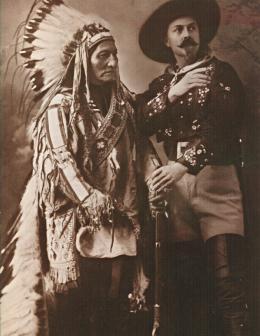The history of the West to 1900 takes up six of nine chapters in Deanne Stillman's new book,
Mustang: The Saga of the Wild Horse in the American West. It's fair to say the book is about cowboys and Indians as well as horses.
Here are a few excerpts from
Mustang to give you a flavor of Stillman's writing. First, on
Custer before Little Bighorn:
On June 16, the Seventh began to encounter with some would later view as portents. They passed an Indian burial ground—an orchard of corpses on scaffolds in trees, including the body of an infant whose face was painted red. Three days later, when the Tongue and Yellowstone rivers join, the Dakota column spent the night at an abandoned Indian camp. The driftwood pony shelters were still there, and the troops used the wood for fires. Again, there was an airborne cemetery, and some of Custer's men stole beaded trinkets from the bodies in the cottonwoods and as the Seventh resumed its march the following day, they brandished the souvenirs from their saddles, not just whistling past the graveyard but taunting the dead to come and get them.On Buffalo Bill's trip to Europe:
As Buffalo Bill sailed into port in 1887, Spain was about to lose Mexico to the United States, the West had been fenced in, and the Indian was not just vanishing but nearly purged from his homeland. The children of England had accomplished much since the Boston Tea Party, and now on board the State of Nebraska, they were met by a tug flying American colors. The passengers cheered in the cowboy band struck up "Yankee Doodle." Cody recorded the moment in his memoir:
A certain feeling of pride came over me when I thought of the good ship on whose deck I stood, and that her cargo consisted of the early pioneers and rude, rough riders from that section, and of the wild horses of the same district, buffalo, deer, elk and antelope—the king game of the prairie—together with over 100 representatives of that savage foe that had been compelled to submit to a conquering civilization and were now accompanying me in friendship, loyalty and peace, five thousand miles from their homes, braving the dangers of the to them great unknown sea, now no longer a tradition, but a reality—all of us combined in an exhibition intended to prove to the center of old world civilization that the vast region of the United States was finally and effectively settled by the English-speaking race.On actor William S. Hart and his 1925 Western
Tumbleweeds:
Critics loved the movie but it did not do well at the box office. Yet Hart was still popular enough to win an invitation to the Little Bighorn battlefield for the fiftieth-anniversary commemorations in 1926. For a famous movie cowboy to speak at the memorial was no small thing; three movies about Custer had already been made, and a "renegade" Indian named Willie Boy had recently been gunned down by a white posse in the Mojave Desert and was billed as the last "wild Indian." At the commemorations, Hart spoke of old warriors in full regalia, "the volleys fired over the graves of the dead, the soft sound of 'Taps' echoed back by the hills like a benediction, the low, weird death song of the Indian women." When he returned to Hollywood, a lifelong fascination with Indians became a defense of Crazy Horse. "Crazy Horse was a very plain man," Hart said, "simple in all his habits, and a great statesmen, and always looking out for the Indians."Comment: Except for the overlong sentence in the Custer excerpt, not bad. Rob says: Check it out. (I'll let you know what I think of it when I get around to reading it.)
For more on the subject, see
The Best Indian Books.



